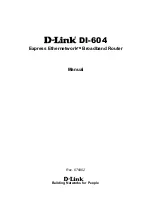
Deployment Guide
19
P
LANNING
In general, the way to increase capacity is to add more access points (within reason) and tune down the radio power
to avoid interference. One reason for deploying a high capacity network is to create a WLAN for voice and data
applications. In such a WLAN, everyone has a VoIP handset running wirelessly all the time.
In general, the following table shows the standard densities for office deployments.
Overcoming Physical Impediments
Not every potential deployment is a standard business campus.The following scenarios are a few that merit special
consideration.
•
Open Space
Open spaces, such as a large foyer or an outdoor area, are very easy to cover with Wi-Fi because there are few
impediments to propagation and fewer opportunities for multipath interference. In such spaces, Wi-Fi signals
can propagate many hundreds of feet. This is good if you want to provide coverage for just a few users.
You will run into challenges if there are many users and high capacity service goals. In these situations, it is
important to tune down the RF to a minimal level. If you are using Aerohive cooperative RF control, the HiveAPs
do this on their own automatically. Another trick is to take advantage of obstacles that block Wi-Fi. Look for
trees or walls and put neighboring access points on either side of them. Doing so limits the interference of the
two access points and allows for the installation of more access points with less interference.
•
Warehouse and Retail
Warehouse and retail environments present many challenges. One of the largest challenges is that RF
characteristics often change because of varying inventory levels and, in the case of retail, seasonal displays
(such as tinsel or a stack of soda cans on an end cap). Additionally, metal shelves and high ceilings can be
challenges to propagation. To resolve with these issues, it is wise to put at least one access point per aisle to
ensure coverage for that aisle. This usually requires a higher density of access points than would otherwise be
required.
•
Configuring Antennas
As anyone who has administered a WLAN system in the past knows, proper configuration of the access point
antennas at the outset can save you lots of trouble. The HiveAP 100 series and HiveAP 320 have internal
antennas that cannot be adjusted. However, the antennas for both the HiveAP 20 and HiveAP 340 are
adjustable. The HiveAP 20 has a pair of fixed, dual-band omnidirectional antennas; and the HiveAP 340 can
support up to six single-band omnidirectional antennas (three for the 2.4 GHz radio and three for the 5 GHz
radio). You typically orient these antennas vertically, positioning the antennas on all HiveAPs in the same
direction. Omnidirectional antennas create a coverage areas that can be toroidal (doughnut-shaped) or cardioid
(heart- or plum-shaped), broadcasting to the sides much more effectively than up or down (see
Figure 1 on
page 20
). In general, this is good for most office environments because you have large flat floors. However, it
can be a problem in environments with high ceilings.
Office Requirements
Expected Data Rate
with 802.11g Clients
Expected Data Rate
with 802.11n Clients
Access Point Density
20 MHz
40 MHz
Coverage (low capacity)
12 Mbps to 24 Mbps
~39 Mbps
~81 Mbps
1 access point per 8000 square feet
Standard office deployment
36 Mbps
~104 Mbps
~216 Mbps 1 access point per 5000 square feet
Standard office deployment
with voice
54 Mbps
~130 – 144
Mbps
~270 – 300
Mbps
1 access point per 2000 – 3000
square feet
Note:
Data rate is not the same as TCP throughput. Because of various headers, inter-frame gaps, and session
creation, real TCP throughput usually does not exceed 22 Mbps at data rates of 54 Mbps.
Summary of Contents for access point
Page 1: ...Aerohive Deployment Guide ...
Page 7: ...HiveAP Compliance Information 6 Aerohive ...
Page 13: ...Contents 12 Aerohive ...
Page 37: ...Chapter 2 The HiveAP 20 ag Platform 36 Aerohive ...
Page 71: ...Chapter 4 The HiveAP 340 Platform 70 Aerohive ...
Page 81: ...Chapter 5 The HiveAP 320 Platform 80 Aerohive ...
Page 105: ...Chapter 8 The High Capacity HiveManager Platform 104 Aerohive ...
Page 123: ...Chapter 10 Using HiveManager 122 Aerohive ...
Page 209: ...Chapter 14 Deployment Examples CLI 208 Aerohive ...
















































